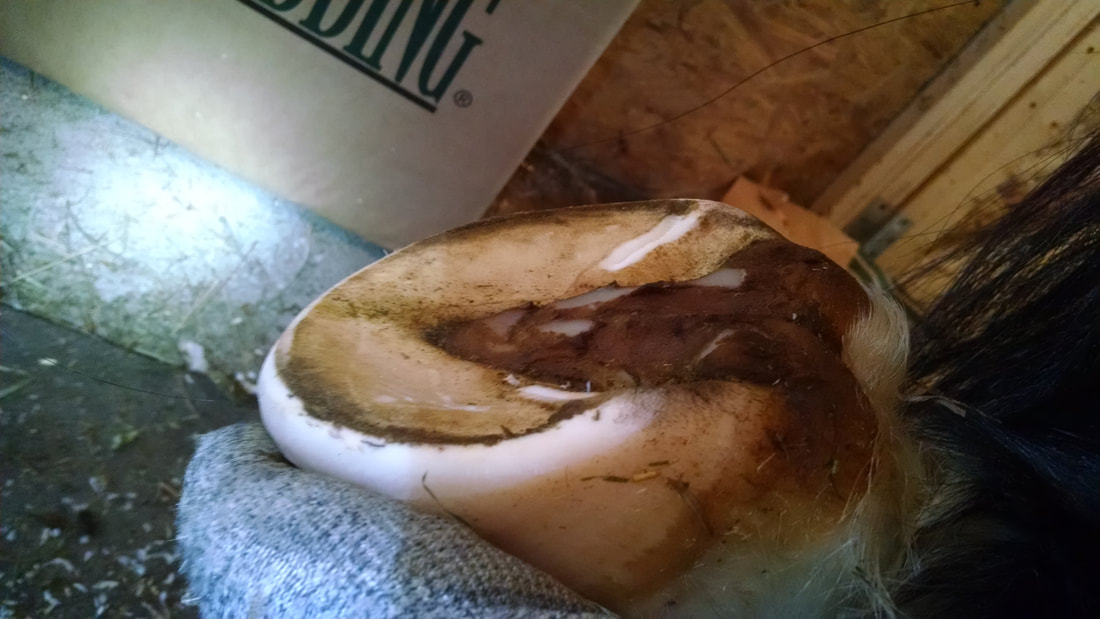As I look out my window at the almost foot and a half of snow accumulation that we've seen this week, I'm inspired to write briefly about the importance of hoof maintenance over the winter. A few clients have wanted to skip having their horses trimmed during the winter months either because they felt they didn't grow enough, they weren't riding and therefore it wasn't important or they felt it was just too much of a hassle to deal with given the erratic weather of the Northeast.
There are quite a few reasons to keep your horse on a regular trimming cycle throughout the winter. First of all, it never hurts to have a professional just keep an eye on your horse. Small changes might not be noticed by the owner who sees the horse every day. Also, while hoof growth does slow in the winter (meaning a longer trim cycle), it doesn't stop all together. Some horses don't slow down at all and any pathology usually requires a shorter trim cycle no matter the season.
Third, if the hoof wall is allowed to overgrow too far, the frog will loose contact with the ground which has several negative effects. It weakens the frog which can start a chain reaction of toe first landings, thrush infections, etc all leading to pathology down the road. It also doesn't allow to the frog to help give the horse any traction over slick terrain like ice and snow. Have you ever noticed that frog tissue is almost the consistency of an eraser or a car tire? That's no accident! Along with the bars, frogs have a big part in adding traction to the bottom of the foot.
Sometimes, in the summer months, with horses on a 4-6 week cycle it's all I can do to keep up with the growth and keep minor problems at bay. Keeping a 6-8 week cycle in the winter allows me to get ahead of some of those small problems and have a healthier foot going into peak riding season!
It's not only important to keep your horse trimmed on a schedule but to keep up on checking your horse's feet regularly on your own. Just because and the ground is covered in snow doesn't mean your horse can't have some of the same troubles they have in the summer like thrush or bruises. I'm not completely unreasonable and I do understand that when it's -20 degrees out, this might not happen as often as we'd do when it's 70 and sunny. But it should still happen at the very least weekly.
I enjoy the seasons and I do like the quiet and peacefulness of winter. But around this time in mid-February, I start getting the itch to put on some boots and hit the trail! I'm studying and seeing what's new in the world of glue-ons for this spring! I'm also participating in and hosting webinars for PHCP: http://pacifichoofcare.net/clinics/ Check them out, you don't have to be a member to participate and they are always full of great information! I hope you all are finding ways to enjoy your horses this winter and appreciating all this solstice has to offer!
There are quite a few reasons to keep your horse on a regular trimming cycle throughout the winter. First of all, it never hurts to have a professional just keep an eye on your horse. Small changes might not be noticed by the owner who sees the horse every day. Also, while hoof growth does slow in the winter (meaning a longer trim cycle), it doesn't stop all together. Some horses don't slow down at all and any pathology usually requires a shorter trim cycle no matter the season.
Third, if the hoof wall is allowed to overgrow too far, the frog will loose contact with the ground which has several negative effects. It weakens the frog which can start a chain reaction of toe first landings, thrush infections, etc all leading to pathology down the road. It also doesn't allow to the frog to help give the horse any traction over slick terrain like ice and snow. Have you ever noticed that frog tissue is almost the consistency of an eraser or a car tire? That's no accident! Along with the bars, frogs have a big part in adding traction to the bottom of the foot.
Sometimes, in the summer months, with horses on a 4-6 week cycle it's all I can do to keep up with the growth and keep minor problems at bay. Keeping a 6-8 week cycle in the winter allows me to get ahead of some of those small problems and have a healthier foot going into peak riding season!
It's not only important to keep your horse trimmed on a schedule but to keep up on checking your horse's feet regularly on your own. Just because and the ground is covered in snow doesn't mean your horse can't have some of the same troubles they have in the summer like thrush or bruises. I'm not completely unreasonable and I do understand that when it's -20 degrees out, this might not happen as often as we'd do when it's 70 and sunny. But it should still happen at the very least weekly.
I enjoy the seasons and I do like the quiet and peacefulness of winter. But around this time in mid-February, I start getting the itch to put on some boots and hit the trail! I'm studying and seeing what's new in the world of glue-ons for this spring! I'm also participating in and hosting webinars for PHCP: http://pacifichoofcare.net/clinics/ Check them out, you don't have to be a member to participate and they are always full of great information! I hope you all are finding ways to enjoy your horses this winter and appreciating all this solstice has to offer!

 RSS Feed
RSS Feed
